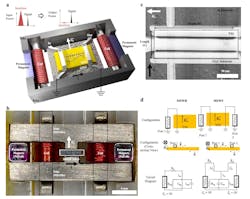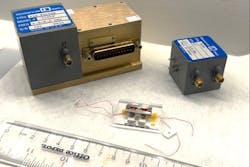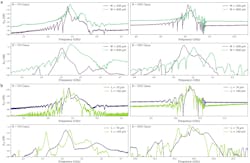Tiny, Magnetically Tuned YIG GHz Filter Eschews Static Power
What you’ll learn:
- Why a tunable GHz-range filter is needed.
- How a new approach to devices based on YIG and magnetic spin waves offers a much smaller and lower-power solution.
- How the new device was implemented along with test results on several different-size units.
Filters have a unique role in circuit and system design. Whether active or passive, they add value by blocking and removing unwanted energy in specific parts of the electromagnetic spectrum. Thus, it proves once again that less is not only more, but, in many cases, it’s also better and required.
The problem is that today’s systems often need lots of filters to accommodate many different slices of the spectrum within a wider band. It’s not unusual to have many tens of them in a design, as myriad designs need these different filters at distributed points in the circuit. However, there’s often a single point in the circuit where a filter must be tuned or physically changed so that it can handle different spectrum demands under different operating modes.
Physically switching filters in and out brings up two issues: First, the obvious need for those many filters, and second, the need for a wideband, loss-loss analog signal switch to select the needed filter. For these reasons, electrically tunable filters are an attractive option, as long as they can deliver the requisite performance. Providing this performance, though, becomes a greater challenge with a signal in the multi-gigahertz range.
Adjustable YIG 3.4- to 11.1-GHz Filter
Addressing this dilemma, a team at the University of Pennsylvania developed a filter that’s adjustable over the range of 3.4 to 11.1 GHz (Fig. 1). Target applications include LEO/MEO satellites, base stations, and fixed-in-place transceivers, but not cellphones. Key to the filter, which needs no power when it’s static and not being tuned, is the use of yttrium iron garnet (YIG), a blend of yttrium, a rare earth metal, along with iron and oxygen.
“What’s special about YIG is that it propagates a magnetic spin wave,” said project leader Troy Olsson, Associate Professor in Electrical and Systems Engineering at Penn Engineering, referring to the type of wave created in magnetic materials when electrons spin in a synchronized fashion. [Ed. Note: Magnetostatic waves (MSW), also known as dipolar spin waves, are long wavelength spin waves where the magnetic dipolar interactions dominate both electric and exchange interactions.] When exposed to a magnetic field, the magnetic spin wave generated by YIG changes frequency. By adjusting the magnetic field, the YIG filter achieves continuous frequency tuning across an extremely broad frequency band.”
The benefits of YIG were discovered in the 1950s and YIG filters have existed for decades. These MSW filters are noted for their wide, continuous-frequency tuning and high-Q values. However, traditional MSW filters employ electromagnets for YIG sphere resonator frequency tuning and as a result, they consume excessive power and space.
Tunable and Tiny Filter
In this new design, current pulses were applied to aluminum-nickel-cobalt (AlNiCo) magnet pieces in the magnetic bias assembly to alter their nonvolatile magnetic remanence and thus tune the cavity center frequency. Using this approach, the tunable magnetic bias circuit only consumes transient power to tune the magnetic field and filter frequency, while it also enables the frequency-tunable filter to operate without any steady-state power consumption.
In addition to being tunable, the new filter is tiny, about the size of a U.S. quarter, and about one-tenth the size of previous generations of YIG filters, which resembled large packs of index cards (Fig. 2). This reduction was achieved by combining the novel circuit with extremely thin YIG films that were micromachined in the university’s Singh Center for Nanotechnology. This dramatically reduced the new filter’s power consumption and size.
Performance was evaluated along several standard perspectives, including Q versus frequency, effect of magnetic-field strength, physical dimensions, and tunability versus flux density (Fig. 3).
The work is described in the team’s readable 10-page paper “Frequency tunable magnetostatic wave filters with zero static power magnetic biasing circuitry” published in Nature Electronics. The paper explains the concept, architecture, fabrication, test results, and other detail. It also includes a comparison of key metrics of their device versus alternative approaches.
The work was supported by a grant from the Defense Advanced Research Projects Agency and made use of resources sponsored by the National Science Foundation National Nanotechnology Coordinated Infrastructure Program.



